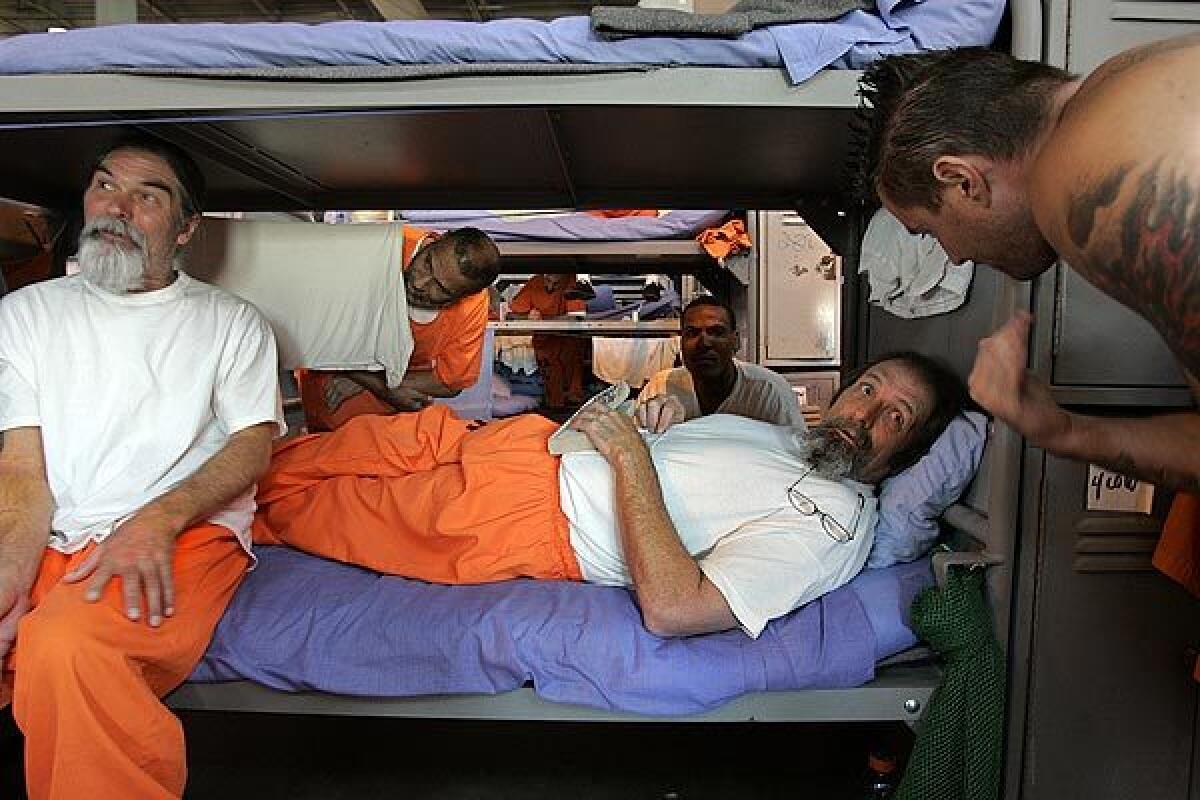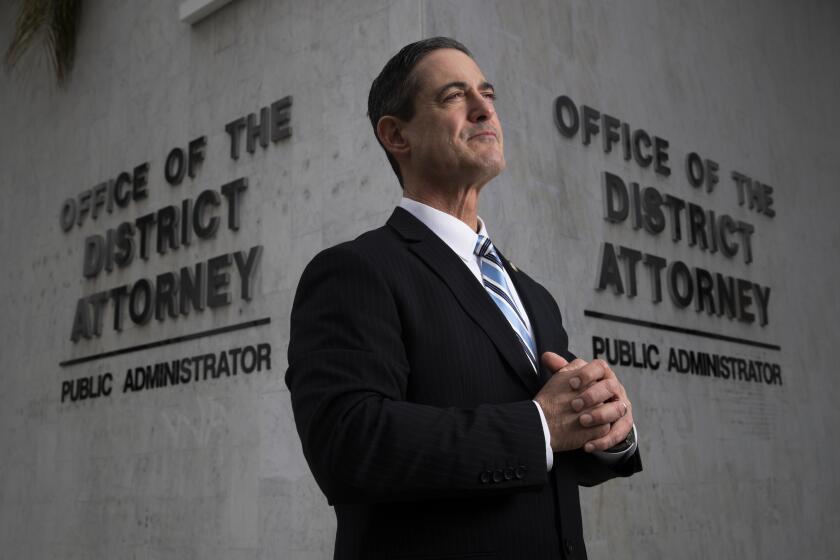Freed inmates face brutal lives of poverty and homelessness. Don’t blame coronavirus

- Share via
Editor’s note: This editorial is the second in a series of three. The first was published Wednesday and the third will be published Friday; you can find them at latimes.com/opinion.
It’s just like in the movies: When a prison inmate’s term ends he’s given some money, a new outfit and a bus ticket back to wherever he lived when he was convicted of his crime however many years before. In California, the amount is $200, minus the cost of the clothes and the bus ride.
And then what? How does a person go home to a place he or she hasn’t seen in decades?
In the midst of the COVID-19 pandemic, released inmates encounter an especially bewildering world. They see scenes fit for science fiction movies or dystopian novels. They see people on the street wearing face masks and police handing out citations to those who cluster too close together in public places. They see shuttered storefronts. They see residents hunkering down in their homes for weeks on end. This was not the world they remember. It’s an especially strange time to come home.
But the ugly truth is that it’s always a strange and difficult time for released prisoners to come home. Except for the clothes, the cash and the bus ticket, most states go out of their way to make life tough for former inmates.
California’s emergency zero-dollar bail order does not force officials to turn criminals loose on the public.
Even in the best of times, affordable housing is scarce. Drug treatment and mental health care are inadequate. Jobs are hard to find, and advancement is usually out of the question because state laws put professional licenses and many academic degrees out of reach of people with criminal records. Regaining basic rights of citizenship — such as voting — can be difficult.
Rough reentry isn’t an outgrowth of the coronavirus. It’s standard operating procedure.
Californians, meanwhile, can be forgiven for mistakenly believing that the pandemic has emptied state prisons and county jails, turning loose a tsunami of ex-inmates and creating a reentry crisis on a previously unseen scale. After all, the state in April announced the early release of 3,500 prisoners to relieve crowding and to stem the spread of infection, and county jail populations have dropped by about 20,000 from their pre-pandemic levels.
While it is true that the flood of former offenders in dire need of services is massive, in fact it’s always been massive. The inflow of new inmates into prisons and jails has temporarily slowed, but the institutions remain full and the outflow is steady. Those 3,500 state prisoners were within several weeks of their release dates and were about to come home anyway — to the same dearth of assistance and opportunity. A similar number of prisoners is released every month, even in normal times, as their terms end.
The Los Angeles County Jail has reduced its inmate population by almost 6,000, but with nearly 12,000 people still inside, it remains the nation’s largest local lockup, more than a third again as populous as the Cook County Jail in Chicago or Rikers Island in New York. And despite its emergency reduction and the steady stream of regularly scheduled inmate releases, the L.A. County jail remains officially full, close to its rated capacity.
In other words, the coronavirus-era scale of need for reentry services is similar to the need in normal times, and similarly unmet. That makes life dangerous for former offenders, who are blocked from taking their rightful places as wage-earning, taxpaying, voting members of the community.
There have been marginal improvements in California over the last decade. By 2010, state prisons were so overcrowded that inmate beds took up every spare inch of floor space. Rehabilitation and reentry programs were scrapped because there literally was no room for them. But federal court orders to reduce the inmate population prompted then-Gov. Jerry Brown and the Legislature to implement a series of reforms, most notably Assembly Bill 109, which assigned people doing time for lower-level felonies to county jails. Voters in 2016 approved Proposition 57, which offered prison inmates a chance at earlier parole for earning education or rehab credits. Gov. Gavin Newsom has vowed to close prisons and expand reentry programs.
On the federal level, conservative and liberal reformers joined with President Trump in 2018 to adopt the First Step Act to reduce federal incarceration and reauthorize funding for reentry programs such as job training and education. The same forces are now seeking a “second step” that would direct millions of dollars toward more ambitious reentry programming. They recognize that $200 and a bus ticket doesn’t cut it.
They could go even further by eliminating restrictions that make former felons ineligible for many professional licenses and academic degrees. They could ensure that coronavirus recovery money for small businesses does not exclude people who have put time in prison behind them. They could prevail upon states such as Florida — where in 2018 voters granted former inmates the right to vote — to scrap completely their barriers to voting and other measures of full participation in society. (A court on Sunday struck down a requirement that Floridians released from prison pay off all fines and fees before exercising their restored right. Gov. Ron DeSantis said he would appeal.)
In Los Angeles County, reform advocates successfully lobbied the Board of Supervisors to stop two new jail projects in favor of a program of alternatives to incarceration. The same programs that are desperately needed to keep people in crisis out of the criminal justice system — mental health care, drug treatment, peer support, meaningful educational and professional opportunities — are needed for people returning after time locked up.
People are coming home from jails and prisons in greater numbers than ever before — not just because of coronavirus concerns, but because counties, states and the federal government are finally coming to terms with years of excessive reliance on incarceration. It’s also time to come to terms with our past fumbling of reentry — our failure to adequately prepare for the safe and successful return to our communities of neighbors and family members, young and old, who have spent part of their lives locked up.
Creating a constructive reentry program will require a close partnership between government and the growing network of service providers, often led by people who did their time in jail or prison and are now equipped with the knowledge and perspective needed by the inmates returning home. The pandemic has highlighted the current system’s inadequacies, but the shortcomings won’t magically disappear after the virus is gone.
More to Read
A cure for the common opinion
Get thought-provoking perspectives with our weekly newsletter.
You may occasionally receive promotional content from the Los Angeles Times.











